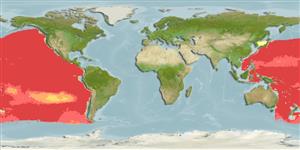Classification / Names
Common names | Synonyms | Catalog of Fishes (gen., sp.) | ITIS | CoL | WoRMS | Cloffa
Actinopterygii (ray-finned fishes) >
Lophiiformes (Anglerfishes) >
Oneirodidae (Dreamers)
Etymology: Tyrannophryne: Greek, 'tyrranos' or Latin, 'tyrannus' = tyrant + Greek, 'phryne' = toad (to mean "tyrannical toad" in reference to its menacing look; common name derived from type species T. pugnax) (Ref. 86949 ). More on author: Regan, Trewavas.
Environment / Climate / Range
Ecology
Marine; bathypelagic; depth range 400 - 2100 m (Ref. 86949). Deep-water, preferred ?
Pacific Ocean: Eastern Central Pacific (Ref. 40966); western and central Pacific, including South Pacific (Ref. 86949).
Size / Weight / Age
Maturity: Lm ? range ? - ? cm
Short description
Morphology | Morphometrics
Dorsal
soft rays
(total): 5;
Anal
soft rays: 5. Metamorphosed females distinguished by having an extremely large oblique mouth; elements of upper and lower jaws extending posteriorly far beyond the base of the pectoral fin and opercular opening; vomerine teeth present or absent; well developed sphenotic spines; well-developed symphisial spine on lower jaw; elongate and tapering angular, forming long narrow spine; hypomandibula with two heads; small quadrate spine, however, longer than articular spine; deeply notched posterior margin of opercle; short and broad subopercle, dorsal end rounded, ventral end nearly circular; toothless pharyngobranchial II; caudal fin lacking internal pigmentation; extremely short illicium, almost totally enveloped by tissue of esca in smaller specimens; well developed first ray of dorsal fin; dorsal fin rays 5; anal fin rays 5; short and broad pectoral fin lobe, shorter than longest rays of pectoral fin; pectoral fin rays 18-20; skin naked, lacking dermal spinules; darkly pigmented skin of caudal peduncle extends well past base of caudal fin (Ref. 86949).
Life cycle and mating behavior
Maturity | Reproduction | Spawning | Eggs | Fecundity | Larvae
Nielsen, J.G., 1974. Fish types in the Zoological Museum of Copenhagen. Zoological Museum of Copenhagen, Denmark. 115 p. (Ref. 38022)
IUCN Red List Status (Ref. 115185)
CITES (Ref. 94142)
Not Evaluated
Threat to humans
Harmless
Human uses
More information
Common namesSynonymsMetabolismPredatorsEcotoxicologyReproductionMaturitySpawningFecundityEggsEgg development
Age/SizeGrowthLength-weightLength-lengthLength-frequenciesMorphometricsMorphologyLarvaeLarval dynamicsRecruitmentAbundance
ReferencesAquacultureAquaculture profileStrainsGeneticsAllele frequenciesHeritabilityDiseasesProcessingMass conversion
Tools
Special reports
Download XML
Internet sources
Estimates of some properties based on models
Phylogenetic diversity index (Ref.
82805): PD
50 = 1.0000 [Uniqueness, from 0.5 = low to 2.0 = high].
Bayesian length-weight: a=0.01000 (0.00244 - 0.04107), b=3.04 (2.81 - 3.27), in cm Total Length, based on all LWR estimates for this body shape (Ref.
93245).
Trophic Level (Ref.
69278): 3.8 ±0.6 se; Based on size and trophs of closest relatives
Resilience (Ref.
69278): High, minimum population doubling time less than 15 months (Preliminary K or Fecundity.).
Vulnerability (Ref.
59153): Low to moderate vulnerability (30 of 100) .
